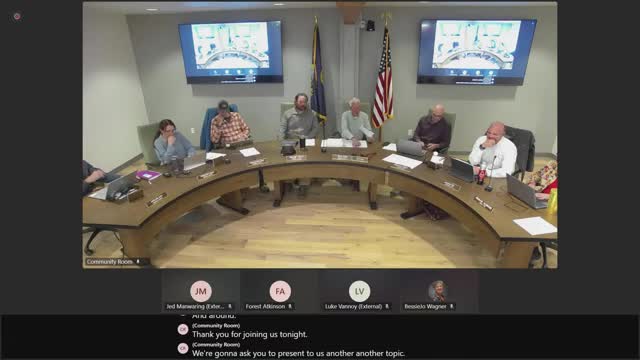Council asks staff for more analysis on traffic guidelines, flags recreational‑seasonal ITE code
October 24, 2025 | McCall, Valley County, Idaho
This article was created by AI summarizing key points discussed. AI makes mistakes, so for full details and context, please refer to the video of the full meeting. Please report any errors so we can fix them. Report an error »

City staff presented a draft Transportation Impact Analysis (TIA) guidelines document and council spent extensive time questioning assumptions about which Institute of Transportation Engineers (ITE) land‑use codes to apply to McCall developments.
Morgan Stroud, City Engineer, explained the draft guidance is intended to give staff and developers a consistent framework for scoping traffic studies, collecting counts and analyzing impacts. He said the document includes flexibility to require additional scope during project review and suggests considering an alternate ITE category sometimes labeled "recreational/seasonal" (ITE land use code 260) for certain residential uses.
Why it matters: Council members raised concerns that code 260 may understate trip generation for McCall, where short‑term rentals, multi‑occupant long‑term rentals and tourism patterns differ from urban commuter communities. Several councilors urged staff to default to more conservative trip generation estimates—or to present side‑by‑side scenarios—so mitigation requirements are not undercounted.
What council asked staff to do
- Provide comparative scenarios showing the traffic impacts using ITE code 210 (single‑family residential) and ITE code 260 (recreational/seasonal), with examples that translate the table values into real‑world trip counts and likely mitigation outcomes.
- Provide the underlying trip‑count data and methodology (including why July counts were used and the city's multi‑year counters) and explain how local peak hours (midday Saturday) differ from the typical weekday commuter peak used in other jurisdictions.
- Clarify how the TIA guideline will interact with roadway design standards and Idaho Transportation Department (ITD) reviews, and whether staff may require developers to present multiple frameworks for assessment when the housing mix is uncertain.
Quotes and debate
"If you think a developer is gaming the system, staff and consultants should make the appropriate choices and ask for the math," Mayor Giles said, cautioning that staff—not developers—must judge the inputs at scoping meetings. Council Member Julie Thrower said the document should include more transparency about how the ITE trip numbers were selected and suggested requiring developers to justify reductions rather than allowing them to start with lower trip assumptions.
Staff response and next steps
Stroud said Kittleson (the city's traffic consultant) advised that the recreational/seasonal code reflects lower annual occupancy and different peak‑hour timing; he also said that nationally recognized ITE data remain the best readily available source but that McCall's unique seasonal patterns warrant additional local guidance. Council directed staff to return in roughly a month with the comparative scenarios, the ITE basis, and a recommendation on whether to remove or limit use of the recreational/seasonal code until more local data exist.
Ending
Councilors agreed the city should adopt a TIA guidance document rather than remain without one. They asked staff to provide clearer scenarios, the underlying data and recommended default handling for developments whose future occupancy or rental model is uncertain.
Morgan Stroud, City Engineer, explained the draft guidance is intended to give staff and developers a consistent framework for scoping traffic studies, collecting counts and analyzing impacts. He said the document includes flexibility to require additional scope during project review and suggests considering an alternate ITE category sometimes labeled "recreational/seasonal" (ITE land use code 260) for certain residential uses.
Why it matters: Council members raised concerns that code 260 may understate trip generation for McCall, where short‑term rentals, multi‑occupant long‑term rentals and tourism patterns differ from urban commuter communities. Several councilors urged staff to default to more conservative trip generation estimates—or to present side‑by‑side scenarios—so mitigation requirements are not undercounted.
What council asked staff to do
- Provide comparative scenarios showing the traffic impacts using ITE code 210 (single‑family residential) and ITE code 260 (recreational/seasonal), with examples that translate the table values into real‑world trip counts and likely mitigation outcomes.
- Provide the underlying trip‑count data and methodology (including why July counts were used and the city's multi‑year counters) and explain how local peak hours (midday Saturday) differ from the typical weekday commuter peak used in other jurisdictions.
- Clarify how the TIA guideline will interact with roadway design standards and Idaho Transportation Department (ITD) reviews, and whether staff may require developers to present multiple frameworks for assessment when the housing mix is uncertain.
Quotes and debate
"If you think a developer is gaming the system, staff and consultants should make the appropriate choices and ask for the math," Mayor Giles said, cautioning that staff—not developers—must judge the inputs at scoping meetings. Council Member Julie Thrower said the document should include more transparency about how the ITE trip numbers were selected and suggested requiring developers to justify reductions rather than allowing them to start with lower trip assumptions.
Staff response and next steps
Stroud said Kittleson (the city's traffic consultant) advised that the recreational/seasonal code reflects lower annual occupancy and different peak‑hour timing; he also said that nationally recognized ITE data remain the best readily available source but that McCall's unique seasonal patterns warrant additional local guidance. Council directed staff to return in roughly a month with the comparative scenarios, the ITE basis, and a recommendation on whether to remove or limit use of the recreational/seasonal code until more local data exist.
Ending
Councilors agreed the city should adopt a TIA guidance document rather than remain without one. They asked staff to provide clearer scenarios, the underlying data and recommended default handling for developments whose future occupancy or rental model is uncertain.
View the Full Meeting & All Its Details
This article offers just a summary. Unlock complete video, transcripts, and insights as a Founder Member.
✓
Watch full, unedited meeting videos
✓
Search every word spoken in unlimited transcripts
✓
AI summaries & real-time alerts (all government levels)
✓
Permanent access to expanding government content
30-day money-back guarantee
